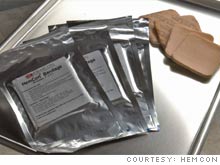|
A shrimp bandage? An exotic military wound dressing invades the civilian market.
PORTLAND, ORE. (FSB Magazine) -- More than half of all military combat deaths result from blood loss. So when Bill Wiesmann and Kenton Gregory developed a shrimp-derived trauma dressing with unique blood-stanching properties, the U.S. military was their first and most obvious customer. The Army had already invested $300,000 in grant funding to help Gregory develop a prototype bandage. The Afghanistan campaign was underway. Iraq lay ahead. The Army wanted its bandages. Now. Gregory, 51, is a research MD who heads the Oregon Laser Center at Provident St. Vincent Medical Center in Portland, Ore. Wiesmann, 60, knew his way through the Pentagon procurement maze, having recently retired from an Army job as head of research on combat-casualty care. The partners hoped to license their bandage to an established health-care company but found no takers. Instead they launched HemCon (short for "hemorrhage control") in the Portland suburb of Tigard. Both men pledged their homes to raise startup capital. The gamble paid off: By the end of 2005 the Army had purchased 100,000 HemCon bandages for more than $90 each. This year the Army is ordering another 180,000 and issuing one to every U.S. soldier in Iraq and Afghanistan and five to every medic.
HemCon's revenues will total about $20 million this year, up from next to nothing in 2003. Now HemCon is trying to turn its military success into a broad-based civilian business. Possible civilian uses for the dressing range from paramedics' kits to more specialized applications, such as stopping bleeding after a hemodialysis (blood cleansing) session for victims of kidney ailments. The HemCon bandage contains chitosan (pronounced KY-ta-san), an organic substance found in crustacean shells. Scientists have long known that chitosan stops bleeding, but Wiesmann and Gregory were the first to develop a chitosan bandage. HemCon's process starts with chitosan processed in Iceland from shrimp shells. After mixing it with acetic acid and turning it into a gel, the material is cast into tiles, each four inches square and a bit more than half an inch thick. The squares are then freeze-dried in a vacuum chamber, compressed to about half their original thickness, and backed with a thin sheet of brown plastic. Now looking like a square beer coaster-and smelling slightly of vinegar-each bandage is sealed in foil and sterilized by gamma radiation. When placed on a wound, the chitosan bandage sticks to surrounding tissue and creates a seal that blocks the flow of blood. The bandage also promotes clotting because blood cells and platelets carry a negative electrical charge and are attracted to chitosan, which bears a positive charge. Chitosan even has antibacterial properties, so it helps ward off infection until a patient reaches a medical facility, where the dressing can be peeled off easily. The bandage has stopped severe bleeding from combat wounds more than nine times out of ten, according to an Army study. Unlike a coagulant powder used by the Marine Corps, which might burn healthy tissue, the HemCon bandage causes no tissue damage. To penetrate civilian markets, HemCon needs to cut costs. HemCon CEO John Morgan, 46, says that higher volumes and improved factory efficiency will soon drive the Army's price per bandage below $80. But civilian sales require extra marketing and inventory expenses, plus profits for distributors and dealers. Morgan estimates that the retail price for a civilian version of the four-by four-inch dressing would be as high as $125.That's a staggering price for health-care professionals used to paying pennies for a gauze bandage. But rescue workers believe that HemCon's product saves money as well as lives. Last June, Tualatin Valley Fire & Rescue, which serves a population of 400,000 in three counties near Portland, Ore., issued bandages donated by HemCon to its 30 paramedic units. Rescue workers found the bandages effective in treating elderly patients who sustained head lacerations in falls, according to EMS chief Mark Stevens. The reason? Many seniors take anticoagulant drugs. They can bleed so profusely from a scalp wound that they require an expensive transfusion. HemCon's dressing mitigates that risk, so Stevens plans to replenish the donated bandages. To keep costs down, he'll probably choose smaller dressings priced around $50 for a two- by four-inch version and $25 for a two by two. Pending FDA approval, HemCon will soon launch a second civilian product, a small chitosan dressing that dentists can stuff into the bleeding socket after a tooth extraction. In clinical trials the bandage stopped bleeding in two minutes or less, vs. ten to 15 minutes for patients who bit down on a wad of gauze. At less than $10, HemCon's dental bandage is a bargain, says Hal Oien, a dentist in Beaverton, Ore., who helped run the trial. Time is money in the oral-surgery business. So dentists often apply a coagulant gel that doesn't work as well as the HemCon dressing and costs about as much. "HemCon's patch closes the wound so well that the usual callback visit might not be needed," Oien adds. As with so many products, the cheapest bandage isn't always the most cost effective. --------------------- RELATED: Small biz's unfair health-care burden America's fastest-growing small public companies |
|

